Say hello to the Spotted Owlet — the tiny, wide-eyed night bird that’s just as comfortable hanging out on a roadside tree as it is perched atop your garden wall. With its round head, spotted coat, and that forever-curious gaze, this owlet may be small in size but it’s big on personality.
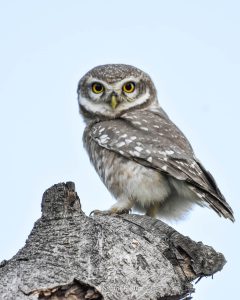
Often seen peeking from tree hollows or old buildings during the day, the Spotted Owlet doesn’t shy away from human company. In fact, it’s one of the most familiar owls across India, making it a favourite among birders and backyard watchers alike.
How to Identify Spotted Owlets
Despite being an owl, this bird is not strictly nocturnal — which means you’ve probably crossed paths with one in broad daylight and wondered, “Is that a baby owl?” Nope, it’s a full-grown Spotted Owlet.
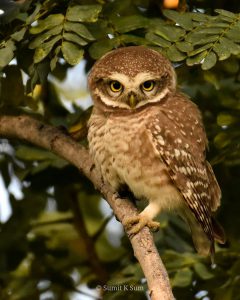
🦉 Key Identification Features of Spotted Owlets
| Size | Around 20 cm tall — about the size of a myna |
| Body | Compact and rounded with a short tail |
| Plumage | Brownish-grey with white spots on the head and upper parts |
| Underparts | Pale, with streaks instead of spots |
| Eyes | Bright yellow and intense, giving it a perpetually surprised look |
| Call | A soft ‘cheevak’ or chuckling trill, often repeated at night or early morning |
Look closely and you’ll often see them bobbing their heads, a behaviour that helps them gauge depth and movement.
Distribution and Habitat of Spotted Owlets
The Spotted Owlet is a true urban survivor, widely distributed across:
| India |
| Nepal |
| Pakistan |
| Sri Lanka |
| Parts of Southeast Asia |
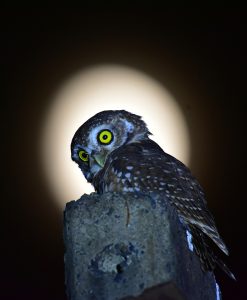
They live in a range of habitats including:
| Open countryside |
| Parks and gardens |
| Village groves |
| Farmlands |
| Ruins and abandoned buildings |
All they need is a few trees to nest in and open ground to hunt — making them well-suited to human-modified landscapes. You might spot one nesting in a crevice on your terrace, or even in the local temple courtyard.
Behaviour and Diet of Spotted Owlets
Spotted Owlets are most active during dawn and dusk, though they can often be seen during the day — especially when disturbed from their roost. You might spot an Indian Pitta hopping through the undergrowth while a Spotted Owlet watches from above.
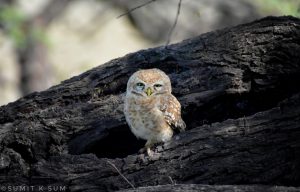
Behaviour Highlights:
| Often seen in pairs or small family groups |
| Loyal to nest sites — same tree hollow year after year |
| Roost in daylight and hunt at night |
| Communicate with a series of soft chirps, clicks, and squeals |
| Known for head bobbing, wing flicking, and comical postures when alarmed |
Diet:
These owlets are carnivorous and highly opportunistic. Their menu includes:
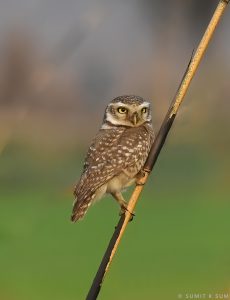
| Insects like beetles, crickets, and moths |
| Small rodents and reptiles |
| Occasionally, small birds and frogs |
They play a crucial role in controlling pest populations — making them a welcome guest for farmers and gardeners.
Breeding and Nesting among Spotted Owlets
Spotted Owlets begin their breeding season in the dry months — typically between November and April. They are cavity nesters, often choosing:
- Tree hollows
- Crevices in old walls
- Abandoned woodpecker holes
- Even gaps in tiled roofs!
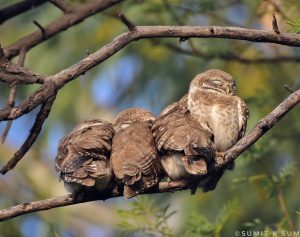
Nesting Behaviour:
| The female lays 3 to 5 eggs |
| Only the female incubates, while the male brings food |
| Chicks hatch after about 3 weeks and fledge within a month |
| Parents are highly attentive, often seen guarding or feeding noisy juveniles |
Young owlets are incredibly cute — with downy feathers and big yellow eyes that look too big for their heads.
Spotted Owlet and Humans
Unlike many other owl species, the Spotted Owlet has adapted beautifully to human-dominated landscapes. In fact, many people consider its presence a sign of good luck or a guardian spirit. While owls are sometimes burdened with superstition, the Spotted Owlet is usually treated with affection and curiosity.
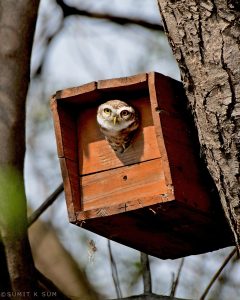
It’s not unusual to find birders or photographers waiting patiently beneath a banyan tree or neem grove, hoping for that perfect peeping-owl photo.
Conservation Status of Spotted Owlets
The Spotted Owlet is classified as Least Concern by the IUCN — and rightly so. It’s widespread, abundant, and shows a remarkable ability to thrive in both rural and urban settings. Unlike the much larger Indian Eagle Owl, the Spotted Owlet is perfectly at ease in your neighborhood park.
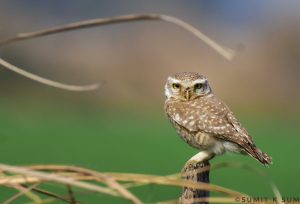
Threats (mostly local):
| Loss of nesting sites due to tree-cutting or modern architecture |
| Pesticide use, which affects their prey population |
| Superstitious killings, though rare, still occur in some regions |
However, with increasing awareness and urban greening efforts, the Spotted Owlet continues to hold its ground — sometimes literally, on your garden fence!
Fun Facts about Spotted Owlets
| Despite their name, Spotted Owlets aren’t baby owls — they’re a separate species of small owl. |
| They bob their heads to judge distance — it’s a depth-sensing trick! |
| They mate for life, and both parents raise the chicks. |
| Their eyesight is amazing, but they rely equally on hearing to hunt in the dark. |
| Unlike typical owls, they are partly diurnal, making them easier to observe. |
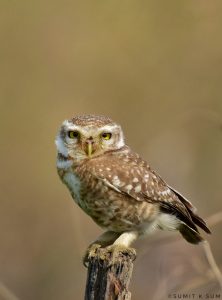
Charming, curious, and utterly photogenic, the Spotted Owlet is one of India’s most delightful backyard birds. It blends the mystery of the night with the familiarity of a garden companion. If you’re quiet and observant, you might just spot one staring back at you from a tree hollow — eyes wide, feathers fluffed, and head tilted in that unmistakably owlish way.
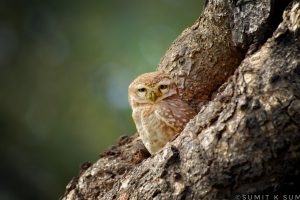
So next time you hear a soft chuckle in the night or spot two yellow eyes blinking from a neem tree, you know who it is — your friendly neighborhood Spotted Owlet, keeping watch under the moonlight.
